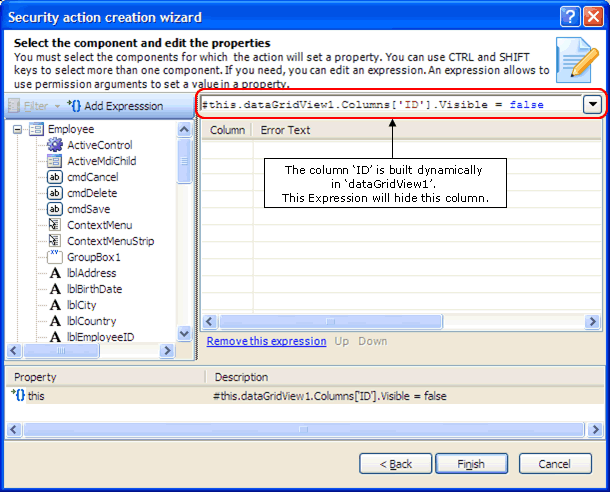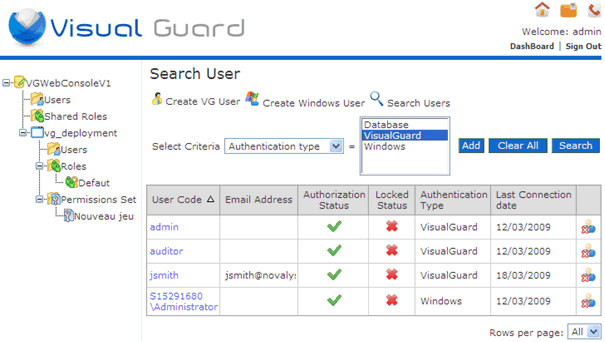We sent you this newsletter because we have been in contact with you about Visual Guard.
If you experience difficulty viewing this message, you can view it online
here
Visual Guard news, tips & tricks:
Find it all in this newsletter!
About Visual Guard: Access Control solution providing Authentication,
Authorizations and Auditing features. Visual Guard supports
.NET applications (Winforms, ASP.Net and Web services), as well
as PowerBuilder applications. More information at: http://www.visual-guard.com
- Download
Visual Guard
What’s new?
Visual Guard 2.8 is available!
Visual Guard 2.8 was released in January and includes the following features:
- Visual Guard Offline mode
Applications secured with Visual Guard .Net have to connect
to the VG security database to fetch the user’s role and
permissions. The security database is stored on your server
which means that the application needs to access the server.
In some situations, the applications cannot access VG Security
database (remote users, for instance)
In this case, you can activate the VG offline store. It will
run offline by caching and serving application security information
locally. It will replace the VG Security Database any time the
application cannot access the Security database.
As soon as there is a connection to the server, the Offline
Store synchronizes with the Security Database. Roles, permissions,
and event log are updated.
- Supporting Dynamic objects
Visual Guard has been improved in version 2.8: you
can define an expression that will change the property of a dynamic
object at runtime. For example, you can hide a column in a dynamic
datagrid.

What’s cooking?
A new version is coming soon! It will be released next month and will include the following features:
With Visual Guard Server, you will be able to secure .Net applications that cannot directly access the Security database. The application will call Visual Guard Server to authenticate users and get their roles and permissions. Then, Visual Guard runtime will adapt the behaviour of the application to the user.
VG Server supports .Net-based applications embedding Visual Guard runtime.
The next version will expose web services to secure non .Net applications.
Visual Guard .Net provides several options for identity and role management. You can use the VG administration console (winform application). Or you can use the Visual Guard API to design an administration form integrated in your application and tailored to your own requirements.
To fit with any architecture, you will soon be able to use VG
web Console. Administrators will only need Internet access to
manage users and roles.

Tip of the month: Permission
on SQL queries
- How to give access to only a subset of data coming from one table?
You have developed an object (visual or non visual)
to retrieve some data form the database and display it on the
client side.
You would like to control access to this data. According to his
role, a user will be allowed to see only some of this data (For
instance, he would see only US employees).
Option 1:
You can build a dynamic query, using a property to define its “where” clause.
You can then dynamically change this where clause with a VG property action.
For instance, you can add a “where” clause to a SelectCommand.SqlDataSource property like this:
| MySqlDataSource.SelectCommand
= {CurrentValue} <new where clause>. |
If the query already contains a “where” clause, you can take it into account with a regular expression:
| #CurrentValue.ToLower.Contains(“
where ”)? string.Format('({0}) and <additional
where clause> ', #CurrentValue):string.Format('({0})
where <new where clause> ', #CurrentValue) |
Option 2:
You can filter data, after the query is executed and the result
set retrieved.
For instance, VG property actions can dynamically change the
following:
• Property “RowFilter” of a “DataView”
• Property “Filter” of a “BindingSource”.
• Property “FilterExpression” of a “SqlDataSource”.
When changing such a filter property, you must check to see
if a filter already exists.
If so, you must add a new clause. Otherwise you can create a
new filter.
A VG property action can change the filter property with a regular
expression like:
| #CurrentValue.Length
== 0?'<New filter>':string.Format('({0}) <additional
filter>,#CurrentValue) |
Tell us what you need!
We value your feedback! Simply reply to this email and tell
us more about your needs and the improvements you would expect
from Visual Guard.
Do not hesitate to forward this newsletter to your colleagues
and friends developing with .NET, they may want to use Visual
Guard to secure their applications.
Request an evaluation version of Visual Guard
We sent you this newsletter
because we have been in contact with you about Visual Guard.
If you no longer wish to get messages from us,
use this link.
|